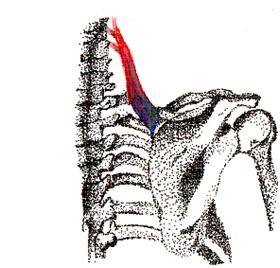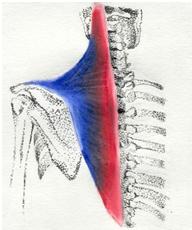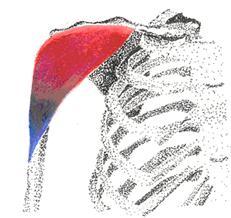The Anatomy Of The Shoulder Quiz
(510).jpg)
The Anatomy of the Shoulder Quiz is an engaging and educational assessment designed to test your understanding of the complex structures and functions of the human shoulder. This interactive quiz focuses on various aspects of shoulder anatomy, including bones, joints, muscles, ligaments, and tendons that contribute to the shoulder's mobility and stability.
By participating in this quiz, you will have the opportunity to evaluate your knowledge of the shoulder's intricate design and its role in facilitating a wide range of movements. The quiz covers topics such as the articulations between the humerus, scapula, and clavicle, as well as the specific Read moremuscles and tendons that enable shoulder motion and maintain joint stability.
Upon completing the Anatomy of the Shoulder Quiz, you will gain insights into your comprehension of this fascinating and essential part of the human body, allowing you to identify areas for further study or improvement. This quiz is an invaluable tool for students, healthcare professionals, and anyone interested in expanding their knowledge of human anatomy and physiology.
The Anatomy of the Shoulder Questions and Answers
- 1.
Name this muscle that elevates the shoulder.
- A.
Quadratus Lumborum
- B.
Biceps Brachii
- C.
Trapezius
- D.
Levator Scapulae
Correct Answer
D. Levator ScapulaeExplanation
The primary muscle responsible for elevating the shoulder is the levator scapulae. This muscle plays a crucial role in the movement and stabilization of the shoulder girdle. Originating from the transverse processes of the upper cervical vertebrae (C1-C4), the levator scapulae inserts into the medial border of the scapula, between the superior angle and the spine of the scapula. When the levator scapulae contracts, it produces a lifting effect on the scapula, which in turn elevates the shoulder. This upward movement is essential for various daily activities, such as reaching for objects or raising the arm above the head. Additionally, the levator scapulae works synergistically with other muscles, like the upper trapezius and rhomboids, to ensure smooth and coordinated shoulder movements.Rate this question:
-
- 2.
Name this muscle the largest of the Shoulder Group.
- A.
Trapezius
- B.
Subscapularis
- C.
Teres Major
- D.
Levator Scapulae
Correct Answer
A. TrapeziusExplanation
The trapezius muscle is the largest muscle of the shoulder girdle and upper back region. It is a broad, flat, and triangular muscle that extends from the base of the skull and the spine to the scapula and clavicle. The trapezius muscle has three distinct parts: upper, middle, and lower, each with specific functions related to the movement and stabilization of the shoulder girdle. The upper trapezius fibers are responsible for elevating, upwardly rotating, and retracting the scapula, as well as extending the neck. The middle trapezius fibers help in scapular retraction, while the lower trapezius fibers contribute to scapular depression and rotation. Collectively, these actions enable a wide range of shoulder movements and posture control.Rate this question:
-
- 3.
This muscle will elevate the arm at the shoulder and flex the shoulder.
- A.
Posterior Deltoid
- B.
Anterior Deltoid
- C.
Middle Deltoid
- D.
Pectoralis Major
Correct Answer
B. Anterior DeltoidExplanation
The correct answer is "Anterior Deltoid." The anterior deltoid is a part of the larger deltoid muscle and is primarily responsible for shoulder flexion and arm elevation. When contracted, the anterior deltoid fibers pull the humerus (upper arm bone) forward, resulting in shoulder flexion and arm elevation. This movement is essential for activities such as reaching forward, lifting objects in front of the body, and maintaining proper posture. The posterior deltoid, on the other hand, is responsible for shoulder extension and external rotation, while the middle deltoid assists in shoulder abduction. The pectoralis major muscle, although it contributes to shoulder flexion, is not a part of the deltoid muscle group.Rate this question:
-
- 4.
What muscle is the prime mover for flexion at the elbow?
- A.
Brachialis
- B.
Biceps Brachii
- C.
Brachioradialis
- D.
Triceps
Correct Answer
B. Biceps BrachiiExplanation
The correct answer is "Biceps Brachii." The biceps brachii is a two-headed muscle located in the anterior compartment of the upper arm. It has two distinct heads: the long head, which originates from the supraglenoid tubercle of the scapula, and the short head, which originates from the coracoid process of the scapula. Both heads merge into a single muscle belly and insert into the radial tuberosity of the radius. As the prime mover for flexion at the elbow, the biceps brachii contracts to bend the elbow and bring the forearm towards the upper arm. This action is essential for various daily activities, such as lifting objects or performing exercises like bicep curls. Additionally, the biceps brachii also contributes to supination of the forearm, which involves rotating the forearm so that the palm faces up.Rate this question:
-
- 5.
Which Muscle is NOT a rotator cuff muscle?
- A.
Supraspinatus
- B.
Infraspinatus
- C.
Teres Major
- D.
Teres Minor
Correct Answer
C. Teres MajorExplanation
The correct answer is "Teres Major." This muscle is not part of the rotator cuff group, but it plays a significant role in shoulder movement and stability. The teres major originates from the inferior angle of the scapula and inserts into the intertubercular sulcus of the humerus. The primary function of the teres major is to perform shoulder extension, which involves moving the arm backward, away from the body. It also contributes to shoulder adduction, bringing the arm closer to the body, and medial rotation, which involves rotating the arm inward. Although the teres major is not a rotator cuff muscle, it works in coordination with the rotator cuff group to ensure smooth and efficient shoulder movements. By understanding the role and function of the teres major, individuals can develop targeted exercise programs and rehabilitation strategies to optimize shoulder strength, stability, and overall performance.Rate this question:
-
- 6.
What muscle is not a prime mover in horizontal adduction of the shoulder?
- A.
Middle deltoid
- B.
Supraspinatus
- C.
Anterior Deltoid
- D.
Biceps (Long Head)
Correct Answer
B. SupraspinatusExplanation
Supraspinatus muscle is not a prime mover in horizontal adduction of the shoulder. It is primarily engaged in abduction and stabilization of the shoulder joint rather than movements towards the midline of the body in the horizontal plane.Rate this question:
-
- 7.
What mucle is the Prime mover of the shoulder?
- A.
Posterior Deltiod
- B.
Infraspinatus
- C.
Teres Minor
- D.
Trapezius
Correct Answer
A. Posterior DeltiodExplanation
The posterior deltoid is the correct answer as it is the main muscle responsible for the movement of the shoulder. It is located at the back of the shoulder and is involved in various movements such as shoulder extension, horizontal abduction, and external rotation. The infraspinatus and teres minor are also muscles involved in shoulder movement, specifically in external rotation. The trapezius muscle, although located in the upper back and neck region, is not considered the prime mover of the shoulder.Rate this question:
-
- 8.
This muscle is NOT responsible for Lateral Rotation at the Shoulder.
- A.
Infraspinatus
- B.
Supraspinatus
- C.
Teres Minor
- D.
Posterior Deltoid
Correct Answer
B. SupraspinatusExplanation
The supraspinatus muscle is not responsible for lateral rotation at the shoulder. Lateral rotation refers to the movement of rotating the arm away from the midline of the body. The supraspinatus muscle is located on the top of the shoulder blade and is primarily involved in the initiation of abduction, which is the movement of raising the arm away from the body. It helps to stabilize the shoulder joint and assist in other movements, but it does not directly contribute to lateral rotation.Rate this question:
-
- 9.
Origin: Infraspinous fossa of scapula Insertion: Middle facet on greater tuberosity of humerus Action: Lateral rotation of the arm
- A.
Supraspinatus
- B.
Infraspinatus
- C.
Teres minor
- D.
Teres major
Correct Answer
B. InfraspinatusExplanation
The correct answer is infraspinatus. The infraspinatus muscle originates from the infraspinous fossa of the scapula and inserts onto the middle facet of the greater tuberosity of the humerus. Its action is to laterally rotate the arm.Rate this question:
-
- 10.
These muscles are responsible for elevation of the shoulder
- A.
Serratus Anterior - upper, Rhomboids, Levator Scapulae, Upper Trapezius
- B.
Subscapularis, Teres Major, Anterior Deltoid
- C.
Lower Trapezius, Serratus Anterior - lower
- D.
Deltoids, Infraspinatus, Teres Minor
Correct Answer
A. Serratus Anterior - upper, Rhomboids, Levator Scapulae, Upper TrapeziusExplanation
The muscles responsible for the elevation of the shoulder are the Serratus Anterior - upper, Rhomboids, Levator Scapulae, and Upper Trapezius. These muscles work together to lift the shoulder and help with movements such as shrugging or raising the arm overhead. The Serratus Anterior - upper, Rhomboids, Levator Scapulae, and Upper Trapezius are all involved in stabilizing and controlling the movement of the shoulder girdle, allowing for proper shoulder elevation.Rate this question:
-
- 11.
__________ is the primary elevator of the shoulder.
Correct Answer
Upper Trapezius, Trapezius, Upper Trap, Trap (upper), TrapExplanation
The primary elevator of the shoulder is the Upper Trapezius muscle, also known as the Trapezius, Upper Trap, or Trap (upper). This muscle is responsible for elevating the shoulder, allowing movements such as shrugging or lifting the arm upwards. It is located in the upper back and neck region and plays a key role in stabilizing and moving the shoulder joint.Rate this question:
- 12.
Discuss tha agaonist/antagonist relationship of muscles
Quiz Review Timeline +
Our quizzes are rigorously reviewed, monitored and continuously updated by our expert board to maintain accuracy, relevance, and timeliness.
-
Current Version
-
Apr 15, 2024Quiz Edited by
ProProfs Editorial Team -
Mar 31, 2009Quiz Created by
Allstaredu
- Bacteria Quizzes
- Bio Quizzes
- Biological Evolution Quizzes
- Biology Exam Quizzes
- Biology Test Quizzes
- Cell Quizzes
- Cell Biology Quizzes
- Chapters Of Biology Quizzes
- Classical Conditioning Quizzes
- Conservation Biology Quizzes
- Enzyme Quizzes
- Fungi Quizzes
- General Biology Quizzes
- Genetics Quizzes
- Immunology Quizzes
- Macromolecule Quizzes
- Marine Biology Quizzes
- Microbiology Quizzes
- Mitosis And Meiosis Quizzes
- Molecular Biology Quizzes
- Parasitology Quizzes
- Prokaryote Quizzes
- Protist And Fungi Quizzes
- Protozoa Quizzes
- Respiratory Quizzes
- Spine Quizzes
- Stem Cell Quizzes
- Taxonomy Quizzes
- Traits Quizzes
- Ultimate Biology Quizzes
- Virus Quizzes
- Zoology Quizzes
 Back to top
Back to top





